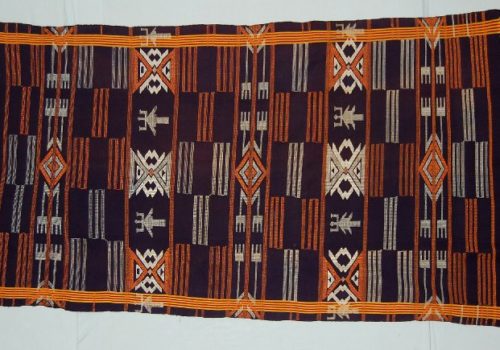Technique
A continuous warp thread gives a solid color background for the motifs. A two color warp background is also used which produces a blended color effect. An iridescent color effect can also be produced when the warp is one color and the base weft (as opposed to decorative motive weft) another. Fabrics are woven to be single faced or double faced, that is the motifs show on both sides. Base fabric is mostly low twist yarn cotton, with the decorative motifs consisting of coarser or heavier spun cotton, low twist silk, or shiny rayon. Cotton and rayon combinations give a multicolored, brocaded look. Earth colors seem to predominate traditionally, but the contemporary access to imported dyes and colored cotton thread has broadened the spectrum.
Application
While the coarse raffia materials are used by masquerades and in the past as head gear for warriors among other uses, the hemp material was used to weave towels, ropes and handbags. The more comfortable and colorful spun cotton is used to weave cloth for everyday wearing.
Meaning & Symbols
The weavers in Akwete claim to know over a hundred different motifs but not more than three or four are usually used simultaneously on one piece of cloth. Traditionally the creator of a new motif is granted an unwritten copyright. This is explained by the inspirational aspect of the development of motifs in the society, certain motifs being regarded as gifts of creative inspiration from a divinity.[3] Social status plays a role in the wearing of Akwete cloth, certain motifs being reserved for royalty, or used as a talisman to protect warriors going into battle or women in pregnancy. Some patterns are reserved for special families or occasions because of circumstances pertaining to motif origin.











3 thoughts on “Akwete cloth”
Comments are closed.